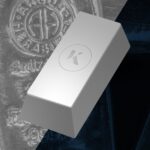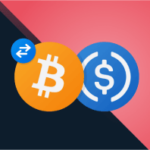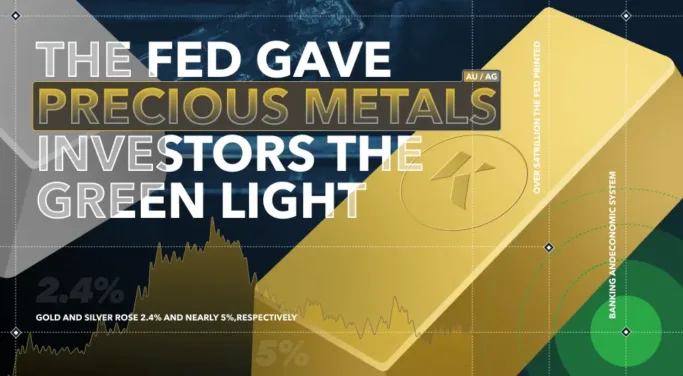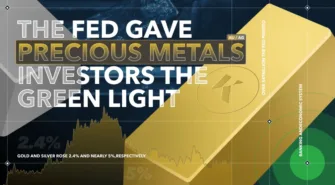Based on the Federal Open Market Committee (FOMC) policy statement from the December FOMC meeting, combined with what I believe are the key comments from Powell’s post-FOMC media circus, the Fed seems to have pivoted toward easing, concerning its interest rate policy.
Signs interest rates will be cut
I believe there was a subtle signal that points to an eventual pivot from Quantitative Tightening (QT) to more Quantitative Easing (QE) and as such, that the Fed has triggered the next big move higher in the precious metals sector.
The Federal Reserve has been signalling the end to interest rate hikes and, in so many words, implying that now the timing of rate cuts is being informally discussed.
While stocks and bonds staged a rally, the precious metals sector sprinted higher. Gold prices and silver prices rose 2.4% and nearly 5%, respectively, while the mining stocks as represented by GDX soared over 6%.
Precious metals bull cycle
The precious metals sector and mining stocks, in terms of percentage price gains, ran circles around the rest of the stock market. This should be the start of a long, sustained bull cycle in the precious metals sector that could surprise even seasoned gold bugs like me with the size of the moves coming.
As an aside, for the Fed to lay itself out as it did after the FOMC meeting, they must be seeing highly adverse events unfolding “behind the curtain” in the banking and economic system.
Here are the salient comments from Powell – take note:
“Policymakers are thinking we have done enough.”
Translation: “put a fork in the rate hikes”
“We haven’t worked out if we will follow a threshold-based path for cutting rates.”
Translation: “We’re already discussing the implementation of rate cuts.”
“You need to reduce restriction on the economy well before 2%.”
This last statement is a measured confirmation that the Fed will soon start to cut rates. However, the term “restriction” is intentionally nebulous. The meaning can encompass both rate hikes and the expansion of the money supply.
Rate cuts in 2024 are a foregone conclusion. However, based on the Fed’s actions this year in response to the banking crisis, “reduce restriction” could mean that the Fed will take further action in 2024 to increase banking system liquidity in several ways other than explicit QE.
Though the Fed reaffirmed that its QT program will remain intact (for now), it has used other means to inject liquidity into the banking system. In March, the $400 billion it printed to prevent even more regional banks from collapsing is one example.
The Bank Term Funding Program, which increases in size almost weekly, hitting an all-time high last week, is another form of QE. The Fed takes long-maturity fixed-income assets at par value from the banks in exchange for giving the banks capital – that’s QE.
Measures the Fed is taking
The Reverse Repo Facility has declined from $2.55 trillion in December 2022 to $823 billion, or $1.7 trillion as of December 13th.
While this does not affect the size of the Fed’s balance sheet, it has enabled the dissemination of that $1.7 trillion into the financial system. The facility served as a “holding tank” for a couple trillion dollars worth the over $4 trillion the Fed printed during the COVID-19 pandemic.
The facility was a way to withhold that money from the financial system and real economy to avert even worse inflation. The Federal Reserve could incentivise the retention of funds in that facility by raising the rate it pays.
Instead, it has let it leak out over the last 12 months because it is needed either to help fund new Treasury debt issuance or shore up banking system liquidity. Though the CPI will be rigged to hide it, this liquidity will stimulate price inflation.
Bank Bailouts
More opaque is a $500 billion bailout facility created in 2021 called the Standing Repo Facility. This facility was the successor to the repo operations that began in September 2019. Establishing it in 2021 ensured that the start of bailout measures was already in place by the time the next big bank crisis hit. This is different from the BTFP because the BTFP is open to any and all banking institutions.
The Standing Repo Facility is limited to the list of primary dealers, which are the big banks, domestic and foreign, that have been approved to help underwrite and fund Treasury debt auctions. The SRF is, in effect, a ready-made QE facility the banks determined to be systemically important.
The Fed thus has a couple of different avenues available by which it can inject liquidity into the domestic and international banking system and it can direct this liquidity at specific banks.
Just recently, a little-known bank outside of Japan was added to the list of banks on the Standing Repo Facility. This is why I believe the Fed has already been engaged in subtle forms of Quantitative Easing.
Despite the FOMC’s affirmation that it will continue with its balance sheet reduction plan, it’s an optical illusion.
The next phase of quantitative easing, also known as “money printing,” has begun and precious metals investors have been given the green light to invest aggressively in the sector.
Dave Kranzler is a hedge fund manager, precious metals analyst and author. After years of trading expertise build-up on Wall Street, Dave now co-manages a Denver-based, precious metals and mining stock investment fund.
This publication is for informational purposes only and is not intended to be a solicitation, offering or recommendation of any security, commodity, derivative, investment management service or advisory service and is not commodity trading advice. This publication does not intend to provide investment, tax or legal advice on either a general or specific basis. The opinions expressed in this article, do not purport to reflect the official policy or position of Kinesis.
















